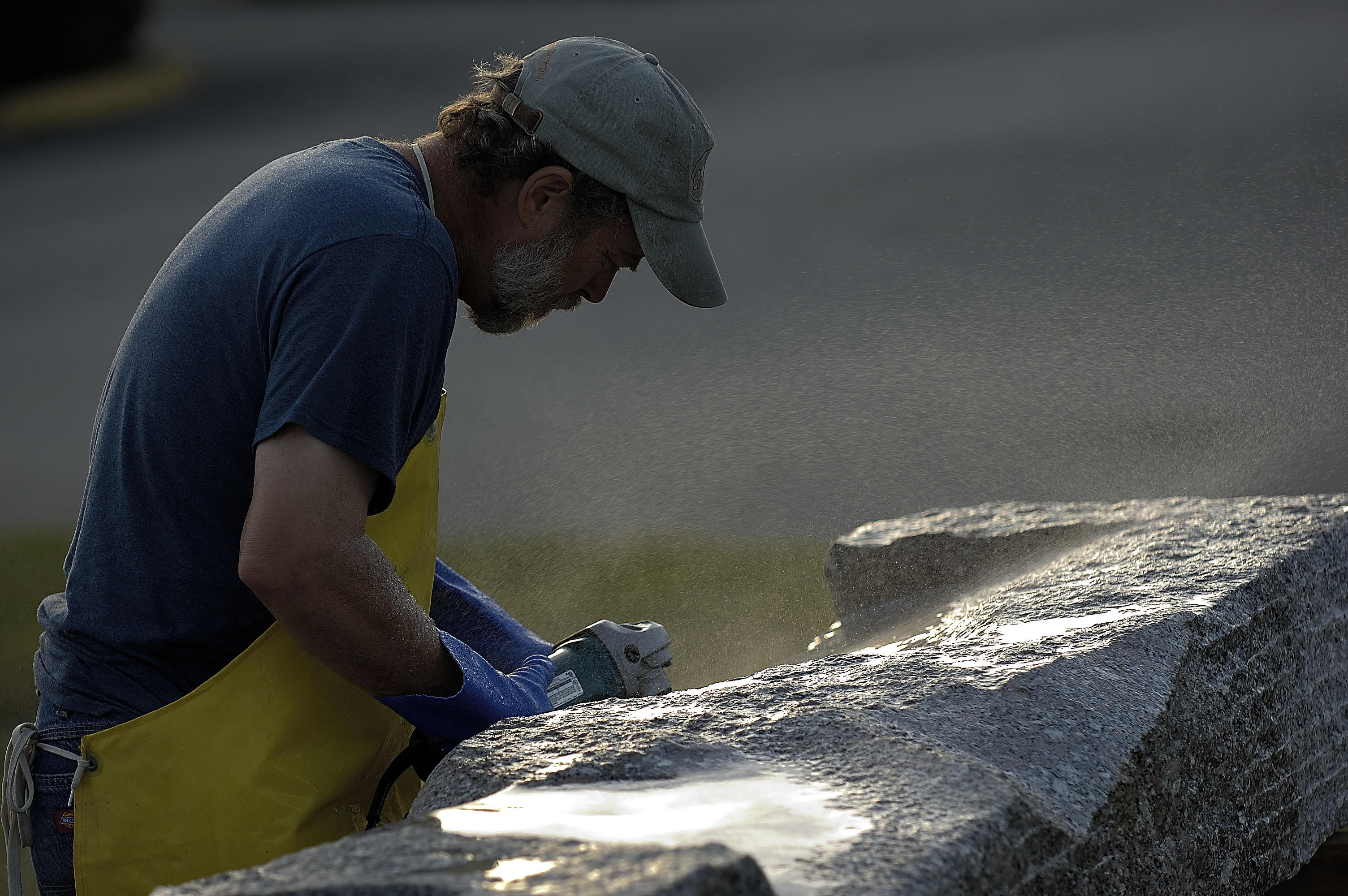
STUDIO TOURS AUTUMN 2022
Paul Heroux New Gloucester, Maine
 I have been working with the ceramic vessel as a painting surface for over forty years, and I am still interested in this three-dimensional canvas because there is always some side hidden, regardless of the vantage point. The patterning on the surface is foremost a response to the form. The imagery has changed over time in reaction to evolving interests and events in my life. Often plant life, erotics, and references to the landscape are present. It is also important to me that my work is visibly strong and durable, so that it invites touch and use. I am a craft artist; tactile experience and the potential for use are crucial to my definition of a craft object. Paul Heroux
I have been working with the ceramic vessel as a painting surface for over forty years, and I am still interested in this three-dimensional canvas because there is always some side hidden, regardless of the vantage point. The patterning on the surface is foremost a response to the form. The imagery has changed over time in reaction to evolving interests and events in my life. Often plant life, erotics, and references to the landscape are present. It is also important to me that my work is visibly strong and durable, so that it invites touch and use. I am a craft artist; tactile experience and the potential for use are crucial to my definition of a craft object. Paul Heroux
Paul works in stoneware and is a master of surface design.
Watch the studio tour video and interview with Paul
Roy Patterson Gray, Maine
 Sculpture is not the language of words. It is the language of shapes, forms, light, space and touch. These elements speak in silence about a world we all knew before we described it with words. Sculpture is not story; it is a presence of space. Certain forms and images are innate to our beings and speak to us with significance. The human figure is my most significant form. It is the means I use to connect art with my experience of life. The creation of Art is the antithesis of the destructive forces that cause so much suffering in the world. Artists, art collectors, and arts organizations share the responsibility to support and nourish creative energy. The channeling of creative energy is an act of peace. Roy Patterson
Sculpture is not the language of words. It is the language of shapes, forms, light, space and touch. These elements speak in silence about a world we all knew before we described it with words. Sculpture is not story; it is a presence of space. Certain forms and images are innate to our beings and speak to us with significance. The human figure is my most significant form. It is the means I use to connect art with my experience of life. The creation of Art is the antithesis of the destructive forces that cause so much suffering in the world. Artists, art collectors, and arts organizations share the responsibility to support and nourish creative energy. The channeling of creative energy is an act of peace. Roy Patterson
Roy works with granite and basalt and has also worked with plaster and molded paper. He selects some of his pieces to be cast in bronze.
Watch the studio tour and interview with Roy >>
Sharon Townshend South Portland, Maine
 My work has always been inspired by nature, both in the free-standing terra cotta sculpture, and the many public art relief murals I have made. There are so many mythologies combining human form with trees. Many cultures see the spirits within. But the caryatids are autobiographical, not in the way of a likeness or a story, but from the inside out. Imagine holding up the sky, or dancing rooted like a tree, slow and sure. They are sentinels, watchers. Bark peels, like garments, revealing smooth and vulnerable skin. The clay sculptures are hollow, their forms created by pushing from the inside. They are metaphoric vessels, like us. Sharon Townshend
My work has always been inspired by nature, both in the free-standing terra cotta sculpture, and the many public art relief murals I have made. There are so many mythologies combining human form with trees. Many cultures see the spirits within. But the caryatids are autobiographical, not in the way of a likeness or a story, but from the inside out. Imagine holding up the sky, or dancing rooted like a tree, slow and sure. They are sentinels, watchers. Bark peels, like garments, revealing smooth and vulnerable skin. The clay sculptures are hollow, their forms created by pushing from the inside. They are metaphoric vessels, like us. Sharon Townshend
Sharon works in stoneware and terracotta at Sawyer Street Studio.
Watch the studio tour and interview with Sharon >>
Ray Carbone Milbridge, Maine
 Skills learned during over forty years of wood and stone carving converge in my sculpture. The tidal zone and its rhythms are my dooryard. My work continues to evolve and be influenced by my sense of place and the rich natural environment surrounding me. I often work with bird imagery; they are fragile, resilient, they go thousands of miles; they weigh two ounces. What more do you need to be inspired? If they can do that and we are disrupting their whole lives, it is plain to see that it is just not right. You take a nature-based symbol and I use it to hopefully, make a connection. It is my public service. I don’t know how to do big things…but I can make a bird carving that can help connect with someone. Maybe I am preaching to the choir, but if beautiful artwork reminds them of something they can connect with, and hopefully activate them to protect the things in the environment. Ray Carbone
Skills learned during over forty years of wood and stone carving converge in my sculpture. The tidal zone and its rhythms are my dooryard. My work continues to evolve and be influenced by my sense of place and the rich natural environment surrounding me. I often work with bird imagery; they are fragile, resilient, they go thousands of miles; they weigh two ounces. What more do you need to be inspired? If they can do that and we are disrupting their whole lives, it is plain to see that it is just not right. You take a nature-based symbol and I use it to hopefully, make a connection. It is my public service. I don’t know how to do big things…but I can make a bird carving that can help connect with someone. Maybe I am preaching to the choir, but if beautiful artwork reminds them of something they can connect with, and hopefully activate them to protect the things in the environment. Ray Carbone
Ray works in both wood and stone selecting some work to be cast in bronze.
Watch the studio tour video and interview with Ray >>
Jesse Salisbury / Kazumi Hoshino Steuben, Maine
 I grew up on the rural and rock-bound coast of Washington and Hancock county Maine and was influenced by this dynamic geology and natural beauty from an early age. My current work and area of exploration are still influenced by the natural world including the way water wears away stone over time, the beauty and texture of a curved split stone, and the visual power of balanced weight on a large scale. I view my art practice as environmental art because I am creating environments and sculptural landscapes out of long-lasting natural materials that I hope can engage the viewer in the beauty, character, and innovation possible from common local materials. Jesse Salisbury
I grew up on the rural and rock-bound coast of Washington and Hancock county Maine and was influenced by this dynamic geology and natural beauty from an early age. My current work and area of exploration are still influenced by the natural world including the way water wears away stone over time, the beauty and texture of a curved split stone, and the visual power of balanced weight on a large scale. I view my art practice as environmental art because I am creating environments and sculptural landscapes out of long-lasting natural materials that I hope can engage the viewer in the beauty, character, and innovation possible from common local materials. Jesse Salisbury
Jesse works primarily with granite and basalt and shares a studio with his wife Kazumi Hoshino
 My work is influenced by nature, environment, time, and current society. Creating art is a method to be myself. I have been creating sculptures with stone as my primary way of expression. I have explored combining simple forms to create complex shapes out of a single stone. I visually represent how complexity can be derived from simplicity, and conversely, how simple the outer shape of a complex form can appear. I have been using the material of stone and other natural resources that attract me and express my ideas. To be able to see simplicity in a complex form is like looking at our lives from a distance. It is like seeing the individual within society’s complexity. This reminds us to look for the natural environment within our current culture. I see an interplay between complexity and simplicity. I want to incorporate the meaning of symbiosis in my work. Kazumi Hoshino
My work is influenced by nature, environment, time, and current society. Creating art is a method to be myself. I have been creating sculptures with stone as my primary way of expression. I have explored combining simple forms to create complex shapes out of a single stone. I visually represent how complexity can be derived from simplicity, and conversely, how simple the outer shape of a complex form can appear. I have been using the material of stone and other natural resources that attract me and express my ideas. To be able to see simplicity in a complex form is like looking at our lives from a distance. It is like seeing the individual within society’s complexity. This reminds us to look for the natural environment within our current culture. I see an interplay between complexity and simplicity. I want to incorporate the meaning of symbiosis in my work. Kazumi Hoshino
Hoshi is from Japan and met Jesse at a Sculpture Symposium there. She works primarily in granite and often on a large scale.
Watch the studio tour and interview with Jesse and Hoshi >>
Melita Westerlund Bar Harbor, Maine
 I see my sculpture as an insertion of line and form into space. I use a welding torch in the same manner a painter uses a brush, defining form with line. “Dancing” around a sculpture, exploring the physical and tactile qualities while attaching, shaping, cutting and reshaping is what I find most satisfying. When the final result encompasses both simplicity and surprise, I have accomplished my goal. Melita Westerlund
I see my sculpture as an insertion of line and form into space. I use a welding torch in the same manner a painter uses a brush, defining form with line. “Dancing” around a sculpture, exploring the physical and tactile qualities while attaching, shaping, cutting and reshaping is what I find most satisfying. When the final result encompasses both simplicity and surprise, I have accomplished my goal. Melita Westerlund
Melita works with painted steel, weathered steel, hand cast and dyed paper, stone, and cement. A native of Finland, she embraces color.
Watch the studio tour and interview with Melita >>
Mark Herrington Franklin, Maine
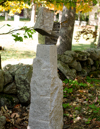 By using stones that have lived through ages geology only hints at, I find myself trying to impose something upon a material that is forcing me to be humble. By adding elements or polishing areas I try to work within the voice of the stone as nature left it and let it speak outside its time scale. The sculpture attempts to realize a timeless ideal and an idealized moment. Mark Herrington
By using stones that have lived through ages geology only hints at, I find myself trying to impose something upon a material that is forcing me to be humble. By adding elements or polishing areas I try to work within the voice of the stone as nature left it and let it speak outside its time scale. The sculpture attempts to realize a timeless ideal and an idealized moment. Mark Herrington
Mark works primarily in granite and basalt. His studio is on a granite quarry.
Watch the studio tour and interview with Mark >>
Wendy Klemperer Nelson, New Hampshire
 My work deals with natural imagery which can function in many different environments. Early on my animal obsession led me to hours of looking, drawing, and fantasizing. I internalized forms and gestures through scrutinizing photos and living animals, which later gave me the ability to put into three dimensions images that exist in my head. This facility is not the objective of my work, but a means to convey an expressive moment. The materials I use retain a raw, rough-edged quality, presenting the image with tactile directness. To make the steel sculptures I search scrap yards for pieces that have been discarded and ravaged by life in the yard. Bent and twisted, such pieces contain energy and a potential new life. The sculptures are not ultimately about animals as anecdotes or records of an actual creature; they use the body language of animals to express a feeling or state of being. This linear evocation elicits a visceral response, despite our insulated, technological culture. Wendy Klemperer
My work deals with natural imagery which can function in many different environments. Early on my animal obsession led me to hours of looking, drawing, and fantasizing. I internalized forms and gestures through scrutinizing photos and living animals, which later gave me the ability to put into three dimensions images that exist in my head. This facility is not the objective of my work, but a means to convey an expressive moment. The materials I use retain a raw, rough-edged quality, presenting the image with tactile directness. To make the steel sculptures I search scrap yards for pieces that have been discarded and ravaged by life in the yard. Bent and twisted, such pieces contain energy and a potential new life. The sculptures are not ultimately about animals as anecdotes or records of an actual creature; they use the body language of animals to express a feeling or state of being. This linear evocation elicits a visceral response, despite our insulated, technological culture. Wendy Klemperer
Wendy welds salvaged steel making animals that appear to be taking their next step.
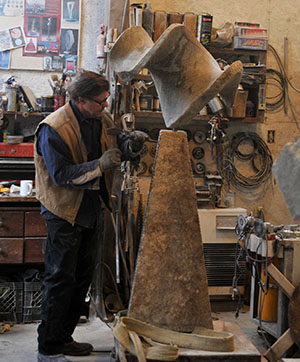
 STEPHEN PORTER Searsmont, Maine
STEPHEN PORTER Searsmont, Maine
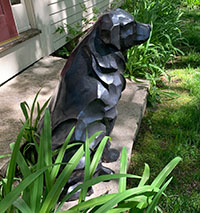
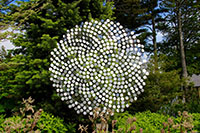 GEORGE SHERWOOD Ipswich, MA
GEORGE SHERWOOD Ipswich, MA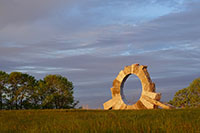 DAVID ALLEN Sebago, Maine
DAVID ALLEN Sebago, Maine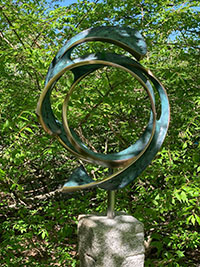 MARK PETTEGROW Kennebunkport, Maine
MARK PETTEGROW Kennebunkport, Maine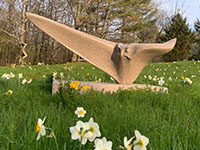 ANDREAS VON HUENE Arrowsic, Maine
ANDREAS VON HUENE Arrowsic, Maine